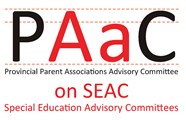Each year SEAC will address the development and review of the Special Education Plan, the Board Improvement Plan for Student Achievement and the Special Education Budget. Each of these activities has a specific deadline and, in order to allow time for adequate planning and review by SEAC members, these items should be scheduled into SEAC Agendas. PAAC on SEAC recommends that SEAC develop an annual plan to support effective SEAC member participation in the school board planning cycle. In Table 1, some key dates that will impact SEAC activities are listed.
Table 1: Important Dates or Deadlines
| August 31 | Year end for School Board Financial Statements |
| PD Days | Typically late August, November, February, April and end of June |
| September 15 | Draft Board Improvement Plan for Student Achievement to be submitted to the Ministry of Education Regional office |
| October 31 | Board Improvement Plans for Student Achievement to be submitted to Ministry of Education Regional Offices |
| October/November | EQAO local results for Grade 3 and 6 tests and Grade 9 Mathematics provided to schools and boards |
| March | Ontario Secondary School Literacy Test (OSSLT) |
| June | EQAO Results for Ontario Secondary School Literacy Test (OSSLT) |
| July 31 | School Board to submit balanced Budget for following year to Ministry of Education
Special Education Plan Checklist to be submitted to the Ministry of Education Regional Office |
Effective Practices to Support Annual Planning by SEAC include:
- Developing an Annual Calendar for SEAC showing what activities SEAC will focus on at each monthly meeting. (Check the PAAC on SEAC website at paac-seac.ca for PAAC on SEAC Annual Calendar for current year.)
- Indicating in the SEAC annual calendar a column for the information SEAC members will need prior to each meeting.
- Using an annual calendar to make sure that the development, or review, of the Special Education Report is considered throughout the year, rather than rushed at the end of the year.
- Listing SEAC training or professional development activities in the annual calendar.
- Orientation or information sessions on the special education budget, prior to the meeting when decisions about budgets need to be made.
- Identifying important deadlines or events, such as the results from Education and Accountability Office (EQAO) and the semi-annual (October and March) Reports of Elementary and Secondary Students, in the calendar.
- Considering new or special initiatives from the Ministry of Education to make sure information is provided to SEAC members.
- Identifying the dates of school board Professional Development or Professional Activity Days, especially those that include a focus on special education, to allow SEAC participation in planning and during the activities.
PAAC on SEAC develops and shares an annual calendar of SEAC activities each fall for distribution to SEAC members, and a sample calendar is included in Table 2. The most recent PAAC on SEAC annual calendar is available on the PAAC on SEAC website at www.paac-seac.ca or from members of PAAC on SEAC, and is usually distributed each September.
Table 2: PAAC on SEAC Annual SEAC Calendar
| ANNUAL CALENDAR OF SEAC ACTIVITIES | ||
| Month | Annual Activities | Activities |
| SEPTEMBER |
|
Request information on:
|
| OCTOBER |
|
|
| NOVEMBER |
|
Request information on:
|
| DECEMBER |
|
Request presentation on School Effectiveness Framework and Board Improvement planning processes |
| JANUARY |
|
Check the EduGains website to see all of the IEP Samples. |
| FEBRUARY |
|
Review parent resources to ensure they are user friendly and easy to understand |
| MARCH |
|
|
| APRIL |
|
Monitor and participate in public consultations on Special Education Plan |
| MAY |
|
|
| JUNE |
|
|
